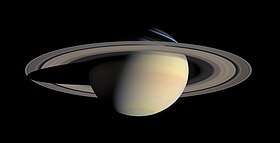User:Amit6/infsaturn
 Saturn, as seen by Cassini | |||||||||||||||||||||
| Designations | |||||||||||||||||||||
|---|---|---|---|---|---|---|---|---|---|---|---|---|---|---|---|---|---|---|---|---|---|
| Adjectives | Saturnian | ||||||||||||||||||||
| Symbol | |||||||||||||||||||||
| Orbital characteristics[1][2] | |||||||||||||||||||||
| Epoch J2000 | |||||||||||||||||||||
| Aphelion | 1,513,325,783 km 10.115 958 04 AU | ||||||||||||||||||||
| Perihelion | 1,353,572,956 km 9.048 076 35 AU | ||||||||||||||||||||
| 1,433,449,370 km 9.582 017 20 AU | |||||||||||||||||||||
| Eccentricity | 0.055 723 219 | ||||||||||||||||||||
| 10,832.327 days 29.657 296 yr | |||||||||||||||||||||
| 378.09 days[3] | |||||||||||||||||||||
Average orbital speed | 9.69 km/s[3] | ||||||||||||||||||||
| 320.346 750° | |||||||||||||||||||||
| Inclination | 2.485 240° 5.51° to Sun's equator | ||||||||||||||||||||
| 113.642 811° | |||||||||||||||||||||
| 336.013 862° | |||||||||||||||||||||
| Known satellites | ~ 200 observed (61 with secure orbits) | ||||||||||||||||||||
| Physical characteristics | |||||||||||||||||||||
Equatorial radius | 60,268 ± 4 km[4][5] 9.4492 Earths | ||||||||||||||||||||
Polar radius | 54,364 ± 10 km[4][5] 8.5521 Earths | ||||||||||||||||||||
| Flattening | 0.097 96 ± 0.000 18 | ||||||||||||||||||||
| 4.27×1010 km²[6][5] 83.703 Earths | |||||||||||||||||||||
| Volume | 8.2713×1014 km³[3][5] 763.59 Earths | ||||||||||||||||||||
| Mass | 5.6846×1026 kg[3] 95.152 Earths | ||||||||||||||||||||
Mean density | 0.687 g/cm³[3][5] (less than water) | ||||||||||||||||||||
| 8.96 m/s²[3][5] 0.914 g | |||||||||||||||||||||
| 35.5 km/s[3][5] | |||||||||||||||||||||
| 0.439 – 0.449 day[7] (10 h 32 – 47 min) | |||||||||||||||||||||
Equatorial rotation velocity | 9.87 km/s[5] 35 500 km/h | ||||||||||||||||||||
| 26.73°[3] | |||||||||||||||||||||
North pole right ascension | 2 h 42 min 21 s 40.589°[4] | ||||||||||||||||||||
North pole declination | 83.537°[4] | ||||||||||||||||||||
| Albedo | 0.342 (bond) 0.47 (geom.)[3] | ||||||||||||||||||||
| |||||||||||||||||||||
| +1.2 to -0.24[8] | |||||||||||||||||||||
| 14.5" — 20.1"[3] (excludes rings) | |||||||||||||||||||||
| Atmosphere[3] | |||||||||||||||||||||
| 59.5 km | |||||||||||||||||||||
| Composition by volume |
| ||||||||||||||||||||
- ^ Yeomans, Donald K. (2006-07-13). "HORIZONS System". NASA JPL. Retrieved 2007-08-08. — At the site, go to the "web interface" then select "Ephemeris Type: ELEMENTS", "Target Body: Saturn Barycenter" and "Center: Sun".
- ^ Orbital elements refer to the barycenter of the Saturn system, and are the instantaneous osculating values at the precise J2000 epoch. Barycenter quantities are given because, in contrast to the planetary centre, they do not experience appreciable changes on a day-to-day basis from to the motion of the moons.
- ^ a b c d e f g h i j k l m Williams, Dr. David R. (September 7, 2006). "Saturn Fact Sheet". NASA. Retrieved 2007-07-31.
- ^ a b c d Seidelmann, P. Kenneth; Archinal, B. A.; a'Hearn, M. F.; Conrad, A.; Consolmagno, G. J.; Hestroffer, D.; Hilton, J. L.; Krasinsky, G. A.; Neumann, G.; Oberst, J.; Stooke, P.; Tedesco, E. F.; Tholen, D. J.; Thomas, P. C.; Williams, I. P. (2007). "Report of the IAU/IAGWorking Group on cartographic coordinates and rotational elements: 2006". Celestial Mech. Dyn. Astr. 90 (3): 155–180. doi:10.1007/s10569-007-9072-y.
{{cite journal}}: CS1 maint: date and year (link) - ^ a b c d e f g h Refers to the level of 1 bar atmospheric pressure
- ^ NASA: Solar System Exploration: Planets: Saturn: Facts & Figures
- ^ Than, Ker (September 6, 2007). "Length of Saturn's Day Revised". Space.com. Retrieved 2007-09-06.
- ^ Schmude, Richard W Junior (2001). "Wideband photoelectric magnitude measurements of Saturn in 2000". Georgia Journal of Science. Retrieved 2007-10-14.
